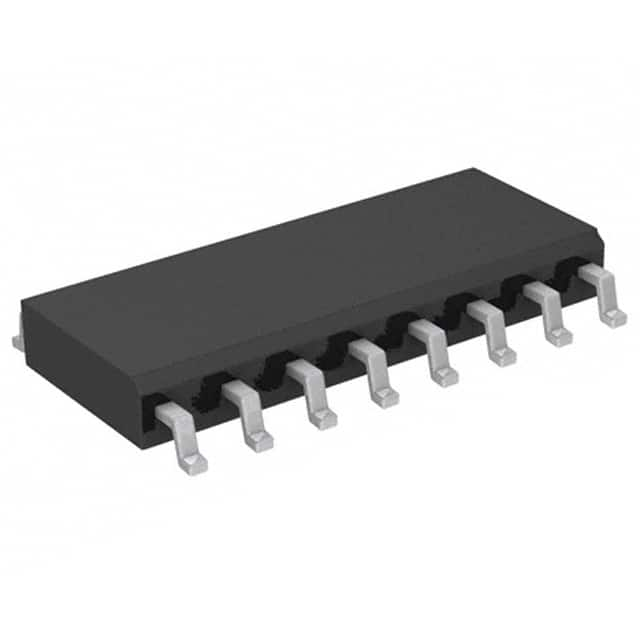Lihat spesifikasi untuk detail produk.

Encyclopedia Entry: 74HCT253D-Q100,118
Product Overview
Category
The 74HCT253D-Q100,118 belongs to the category of integrated circuits (ICs).
Use
This IC is commonly used in digital electronics for data multiplexing applications.
Characteristics
- High-speed operation
- Low power consumption
- Wide operating voltage range
- Compatibility with TTL inputs
- Schmitt-trigger action on all inputs
- Balanced propagation delays
Package
The 74HCT253D-Q100,118 is available in a small-outline package (SOIC) with 16 pins.
Essence
The essence of this product lies in its ability to efficiently multiplex data signals in digital systems.
Packaging/Quantity
The 74HCT253D-Q100,118 is typically packaged in reels or tubes, and each reel/tube contains a specific quantity of ICs. The exact packaging and quantity may vary depending on the manufacturer.
Specifications
- Supply Voltage Range: 2V to 6V
- Input Voltage Range: 0V to VCC
- Output Voltage Range: 0V to VCC
- Operating Temperature Range: -40°C to +125°C
- Maximum Propagation Delay: 25 ns
- Maximum Quiescent Current: 4 μA
Pin Configuration
The 74HCT253D-Q100,118 IC has 16 pins arranged as follows:
___________
A1 | 1 16 | VCC
B1 | 2 15 | S1
C1 | 3 14 | S0
D1 | 4 13 | GND
D2 | 5 12 | Q1
C2 | 6 11 | Q0
B2 | 7 10 | Q3
A2 | 8 9 | Q2
‾‾‾‾‾‾‾‾‾‾‾‾‾
Functional Features
The 74HCT253D-Q100,118 is a dual 4-input multiplexer with common select inputs (S1 and S0). It allows the selection of one out of four data inputs (A1 to D1 or A2 to D2) for output (Q0 to Q3) based on the select inputs.
Advantages and Disadvantages
Advantages
- High-speed operation enables efficient data multiplexing.
- Low power consumption makes it suitable for battery-powered devices.
- Wide operating voltage range provides flexibility in various applications.
- Compatibility with TTL inputs allows easy integration with existing systems.
- Schmitt-trigger action on all inputs ensures noise immunity.
- Balanced propagation delays ensure accurate signal transmission.
Disadvantages
- Limited number of input and output channels may restrict certain complex applications.
- Lack of built-in protection features against electrical faults may require additional circuitry.
Working Principles
The 74HCT253D-Q100,118 operates based on the principle of digital multiplexing. The select inputs (S1 and S0) determine which data inputs (A1 to D1 or A2 to D2) are connected to the outputs (Q0 to Q3). By changing the select inputs, different combinations of data inputs can be selected for output.
Detailed Application Field Plans
The 74HCT253D-Q100,118 finds applications in various fields, including: 1. Data communication systems 2. Digital signal processing 3. Industrial automation 4. Consumer electronics 5. Automotive electronics
Detailed and Complete Alternative Models
Some alternative models to the 74HCT253D-Q100,118 include: - SN74HCT253N - CD74HCT253E - MC74HCT253N - 74HCT253PW,118
These alternative models offer similar functionality and can be used as substitutes depending on specific requirements.
In conclusion, the 74HCT253D-Q100,118 is a versatile integrated circuit used for data multiplexing applications. Its high-speed operation, low power consumption, and compatibility with TTL inputs make it suitable for various digital systems. However, its limited input/output channels and lack of built-in protection features should be considered in complex applications.
Sebutkan 10 pertanyaan dan jawaban umum terkait penerapan 74HCT253D-Q100,118 dalam solusi teknis
Sure! Here are 10 common questions and answers related to the application of 74HCT253D-Q100,118 in technical solutions:
Q: What is the function of the 74HCT253D-Q100,118? A: The 74HCT253D-Q100,118 is a dual 4-input multiplexer with 3-state outputs. It can select one of four data inputs and route it to the output.
Q: What is the operating voltage range for the 74HCT253D-Q100,118? A: The operating voltage range for this IC is typically between 4.5V and 5.5V.
Q: How many outputs does the 74HCT253D-Q100,118 have? A: This IC has two 3-state outputs, which means it can drive two separate output lines.
Q: Can the 74HCT253D-Q100,118 be used in high-speed applications? A: Yes, this IC is designed for high-speed operation and can be used in applications where fast switching is required.
Q: What is the maximum frequency at which the 74HCT253D-Q100,118 can operate? A: The maximum frequency for this IC is typically around 70 MHz.
Q: Can the 74HCT253D-Q100,118 handle both digital and analog signals? A: No, this IC is specifically designed for digital signals and may not perform optimally with analog signals.
Q: Does the 74HCT253D-Q100,118 have any built-in protection features? A: Yes, this IC has built-in ESD protection on all inputs and outputs, which helps protect it from electrostatic discharge.
Q: Can the 74HCT253D-Q100,118 be used in automotive applications? A: Yes, this IC is qualified for automotive applications and meets the necessary standards.
Q: What is the power consumption of the 74HCT253D-Q100,118? A: The power consumption of this IC depends on the operating conditions but is typically low.
Q: Are there any specific layout considerations when using the 74HCT253D-Q100,118? A: Yes, it is recommended to follow the manufacturer's guidelines for PCB layout and ensure proper decoupling capacitors are used for stable operation.
Please note that these answers are general and may vary depending on the specific application and requirements. It is always advisable to refer to the datasheet and consult with the manufacturer for detailed information.

